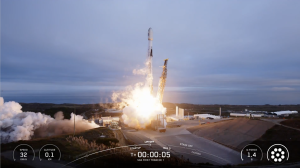SDA restructuring ground support program for experimental sats to focus on fire-control missions

The Space Development Agency is reworking its effort to provide ground infrastructure for upcoming experimental satellites to focus solely on advanced fire-control capability demonstrations, according to SDA Director Derek Tournear.
In late 2023, the agency initiated contracting efforts for the Proliferated Warfighter Space Architecture Future Program (PFP) Ground Segment Integration (PGI) program — intended to provide ground infrastructure and resources for a range of experimental missions on orbit. After receiving feedback from industry, SDA has modified the program’s scope to concentrate on ground support for the Fire-control On Orbit-support-to-the-war Fighter (FOO Fighter) satellites and other fire-control satellites.
Speaking to a small group of reporters Friday, Tournear explained that officials decided to change the PGI program because the initial requirements for the effort were too broad for industry to execute.
“It would have been very difficult for us to scope in a way that a vendor could properly bid,” he said. “If we wanted them to bid the ground support for everything from a small CubeSat-type demo that could have extremely high classification requirements, to something that was very open but a larger satellite, such as FOO Fighter, the requirements were significantly different.”
Now, the agency plans to award two separate contracts for fire-control ground infrastructure: the Advanced Fire Control Ground Integration (AFCGI) and the Advanced Fire Control Mission Integrator (AFCMI).
The vendor contracted for the AFCGI effort will be responsible for building out the developmental operations center at Redstone Arsenal, where they will provide the ground infrastructure, cloud hosting capabilities and IT resources for the ground entry points of the fire-control satellites, Tournear said.
At the same time, the AFCMI contract will include capabilities to fuse data from FOO Fighter and other fire-control satellites so that it can be passed off to warfighters, he noted.
“We were getting feedback from a lot of different vendors that the skill sets were significantly different enough that we would not be getting the best of breed if we mixed them together and essentially forced them to do different teaming agreements,” Tournear said. “They would make compromises on [things like], to get the best mission integrator they might not have the best ground integrator, or vice versa.”
SDA will post a notice to industry Friday detailing the restructuring, Tournear said. An official request for proposals for AFCGI is slated to be posted by mid-June, followed by a second RFP for AFCMI by the end of the summer.
The agency plans to award contracts for the effort starting in December, with the intention to have all of the necessary ground infrastructure and mission integration capabilities in place by summer of 2026.
SDA awarded Boeing-subsidiary Millennium Space Systems a $414 million contract in April to build eight satellites for the FOO Fighter program. The small constellation is intended to demonstrate next-generation fire-control capabilities — using sensors to create high-fidelity tracking data of advanced missile threats, such as hypersonic weapons, that includes the exact position and time accuracy needed to intercept and defeat them.
Because it is an on-orbit experimental program, the satellites are not directly part of SDA’s upcoming mega-constellation of missile tracking and data relay satellites known as the Proliferated Warfighter Space Architecture (PWSA). The agency is currently targeting a launch date in the first quarter of fiscal 2027 for FOO Fighter.
As for the other demonstrations planned for the PFP effort that are not related to fire-control, the prime contractors will be responsible for supporting ground infrastructure and integration efforts moving forward, Tournear said. Upcoming contracts for these programs — like the Transport Layer Tranche 2 Demonstration and Experimentation System (T2DES) effort — will include additional ground support requirements, he noted.
“The ground efforts for those, we will treat more as experiments and we will have that be part of the scope for the space vehicle vendors themselves,” he explained. “Anything that is part of the PFP program that is very experimental by nature, the ground and operations will be done by the space vehicle vendors.”
The agency will have to modify some of the contracts already awarded, such as those to York Space Systems for the Tranche 1 Demonstration and Experimentation System (T1DES) program and Ball Aerospace for the National Defense Space Architecture Experimental Testbed (NExT) satellites. Tournear noted that SDA is already in discussions with both vendors to do so.
“They’re not significant changes, as the programs were already going to incorporate a good portion of the ground,” he said. “But as mentioned, since they’ll be providing their own ground entry points there will be some modifications.”






